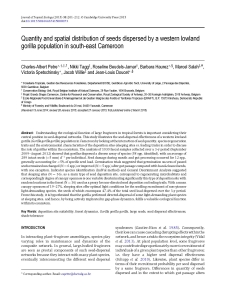Petre C.A., Tagg N., Beudels-Jamar R., Haurez B., Salah M., Spetschinsky V., Willie J., Doucet J.L.
Understanding the ecological function of large frugivores in tropical forests is important considering their central position in seed-dispersal networks. This study illustrates the seed-dispersal effectiveness of a western lowland gorilla (Gorilla gorilla gorilla) population in Cameroon by looking at the interaction of seed quantity, species regeneration traits and the environmental characteristics of the deposition sites (sleeping sites vs. feeding trails) in order to discuss the role of gorillas within the ecosystem. The analysis of 1030 faecal samples collected over a 3-y period (September 2009–August 2012) showed that gorillas dispersed a diverse array of species (58 spp. identified), with an average of 289 intact seeds (>5 mm) d−1 per individual. Seed damage during mouth and gut processing occurred for 12 spp., generally accounting for <5% of specific seed load. Germination trials suggested that germination success of passed seeds remained unchanged (N=6 spp.) or improved (N=5 spp.) after gut passage compared with hand-cleaned seeds, with one exception. Indicator species identification (IndVal method) and General Discriminant Analysis suggested that sleeping sites (N = 36), as a main type of seed deposition site, correspond to regenerating microhabitats and correspondingly degree of canopy openness is one variable discriminating significantly this type of deposition site with random locations in the forest (N=36) used as a proxy for non-directed seed deposition on feeding trails.With a mean canopy openness of 19–27%, sleeping sites offer optimal light conditions for the seedling recruitment of non-pioneer light-demanding species, the seeds of which encompass 47.4% of the total seed load dispersed over the 3-y period. From this study, it is hypothesized that the gorilla performed directed-dispersal of some light-demanding plant species at sleeping sites, and hence, by being actively implicated in gap-phase dynamics, fulfils a valuable ecological function within its ecosystem.
Consultez la notice complète de l’article sur ORBi

